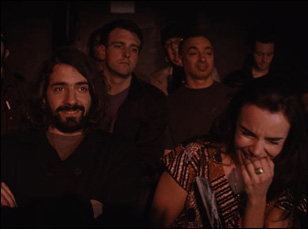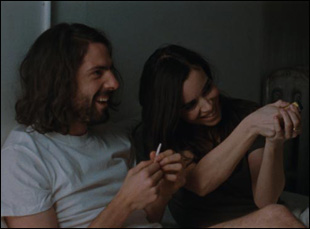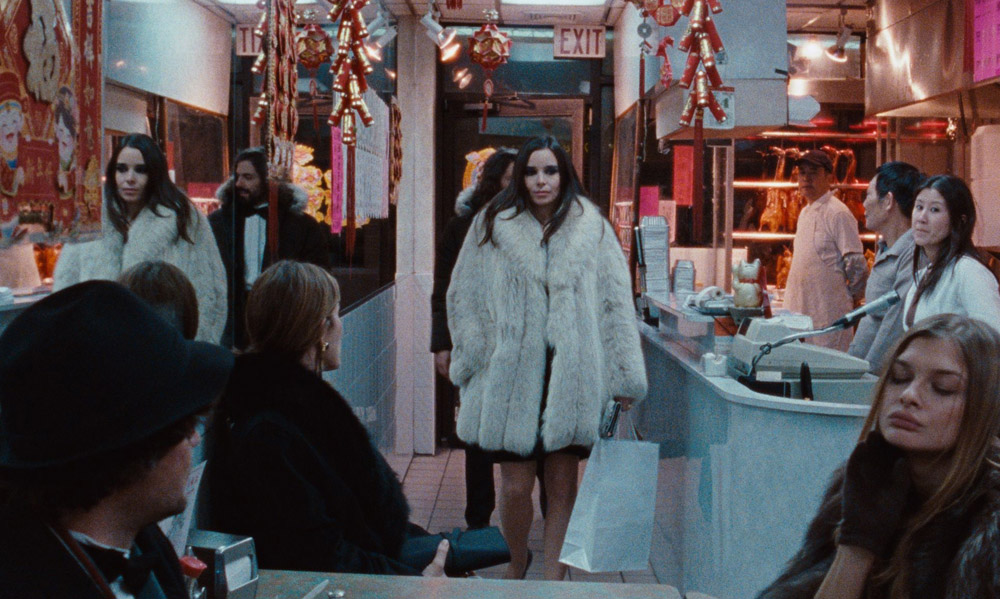In honor of Cinema Arabiyya‘s inaugural screening of the “The Imperialists Are Still Alive” at Nitehawk Cinema in Williamsburg on April 24th, we’re revisiting this interview originally published on IFC.com on April 14th, 2011.
Like the unsatisfied pleasure seekers in Luis Bunuel’s “The Discreet Charm of the Bourgeoisie” or later Whit Stillman’s “Metropolitan,” the protagonists of Zeina Durra’s “The Imperialists Are Still Alive” are chasing a satisfaction that no party will provide as they strut through gallery openings, soirees in the backrooms of Chinese kitchens, and other dimly lit social functions in Manhattan. But in a novel twist, Durra brings an unwelcome guest to the proceedings when the leader of the pack, a visual artist named Asya (Élodie Bouchez) discovers that an ex-boyfriend may have disappeared at the hands of CIA, a concern that might seem paranoid if it weren’t for the fact that both feel the scrutiny of living in a post-9/11 America.
That might sound like heady prestige bait for most filmmakers, but for Durra, the Oxford-educated daughter of Bosnian and Jordanian parents who spent the early 2000s attending film school at NYU, it’s obviously personal not just because of autobiographical similarities but rather since it’s laced with a singular sense of humor that challenges the importance of art and the permanence of identity while carrying an air of idiosyncrasy that only could come from a perspective of an outsider looking in. In New York once more to promote the film, Durra and the French star Bouchez spoke about what it was like to make the satire, how “Metropolitan” director Stillman came in for a cameo and how it’s far from what most independent cinema is these days.

Élodie Bouchez: Zeina. [laughs] No, simply, I really loved the script, which was very well written and structured and then I saw Zeina’s first film [the 2005 short “Seventh Dog”] that I really enjoyed too and I could feel that she was a really talented director. Then I met her and decided to do this movie together.
Zeina, what made you want to do this film and with Élodie?
Zeina Durra: I didn’t want to make one of those really bad movies with an artist who really wasn’t an artist that was painting bad canvasses – you know, those kind of bad indie films. So I thought I really need a French actress and because being an artist is all about energy, I was talking to [my casting director] about French actresses and he’s goes, “Well, I think Élodie would be perfect.” And I thought that was kind of out of our league and he said, “No, I just sent her the script. Let’s just give it a try.” So that all really worked out and it was a joy to work with her. We did a lot of prep work, she learned some Arabic. We really worked on how to get the character perfect and I think that shows in the film.
The film ultimately says some really interesting things about art – obviously, it’s very important to both of you, but at the same time, it shows how trivial it can be when compared to real world events and there’s one scene in particular that mocks an interpretive dance troupe called Environmental Dance that attempts to bridge the two. Since you work in the field, how do you reconcile those things?
Zeina Durra: I think that’s funny because everyone has brought that up, but for me, I just wanted to show this milieu [Asya’s] in, so as a dance troupe, it’s more like it was a really painful exercise to watch and as all young artists or non-artists, you go and you watch your friends’ work or and there’s always that moment of “Well, what happens if it’s dreadful” and how do you deal with that? So I thought that’d be really interesting bonding moment for the couple in the film because it’s their first proper date. And I didn’t want it to be silly. I wanted it to be something that went a bit wrong. Like it could’ve been good, but there was just something off in it and it was ridiculously funny as opposed to silly funny.
So that was that, but then the art thing, there’s always a struggle that any artist has or anyone that’s not like a doctor in a war zone that has a conscience has, which is how do you justify your day-to-day when there’s some crazy stuff going on and you think that your work is worthless. Ultimately, it’s more complex than that because you do need people thinking out there to try and put ideas out there to inspire society and to make society a better place. I do think art is very important for that, but there’s always those quite awkward moment when there’s a tsunami in Japan and it seems like what you’re doing is frivolous when maybe it isn’t. You have to keep that in mind when you’re doing art – that it is important, but obviously you’re going to have days when you think it’s like why the hell am I choosing this really tough profession that at the same time is pretty indulgent sometimes to the rest of the world.
Was it hard to strike the right tone for this?
Zeina Durra: I think the hardest thing about the film was people didn’t get that I knew what the tone of the film was and I’d written the script. I thought Élodie got the tone, right?
Élodie Bouchez: Yes, of course, I got the tone because for me, it was already in the writing. The scenes are surreal sometimes, but in such a funny way, and I’m sure it takes a lot of work as a writer to get to that level of certainty in the humor and knowing Zeina, I guess that this tone also comes from her personality and the way she looks at the world and the way she looks at her characters, her story and her actors.
For Élodie, was it an interesting dynamic on set when in a film that’s personal for its director like this, you’re playing a version of your director? You don’t want to mimic her, but at the same time, you’re playing her onscreen surrogate.
Élodie Bouchez: Yeah, the question’s never been to mimic her. She never asked me to do that.
Zeina Durra: It would’ve been a bad film! [both laugh]
Élodie Bouchez: [There was] some inspiration and we just tried together to put in that third person that was the character, which was [between] me and which was Zeina completely in a way to give her that kind of complexity and dynamic. So it’s more like we both worked on [a character in the middle].
Zeina Durra: Yeah, completely. I didn’t go into whether it was me or not. I just wanted to have what I had in my head and wanted to say it out onscreen.

Zeina Durra: It was really fun. All our actors were great and we were a fun crew and we worked really hard and there were 23 days, so it was very arduous and it was very cold, but somehow we just all cracked up the whole time.
Élodie Bouchez: Yes, the limited amount of time that we had wasn’t comfortable, but it just gave us a great energy and sometimes we had to go from the party makeup to very natural makeup and then go back to the party makeup – we would all put a lot of good energy into making our days and that was fun.
Was this bringing back some memories of some really bad or interesting parties you’ve attended?
Zeina Durra: That’s the whole New York thing about being young and going out and for me, because I was here during 9/11 and obviously before and after, people were still doing that sort of stuff, it was always quite surreal sometimes when you were in those situations, especially when everyone was being bombed and you were living your life. There was all this parallel stuff going on, so when I watch the film, it obviously brings back memories.
It reminded me in a very direct way of “Metropolitan” – and in fact, Whit Stillman shows up for a cameo as a gentleman who tries to impose himself on unsuspecting partygoers while dancing. How did that cameo come about?
Zeina Durra: Vanessa [Hope], my producer, is friends with him and she basically asked him if he would — we needed like a Euro banker and she said, “Oh, Whit would be perfect. He’d love to do it.” And that’s how he came on and it was just great because his work resonated with mine because I really do love his films.
How interesting has it been to get an American reaction? It’s very much an American film and at the same time, it would seem like people talk to you about it in foreign terms.
Zeina Durra: It was a hard film in that sense because it is a very American film, but it’s not made in an indie American way and it wasn’t in the way that we shot it, like the no time and no money, but the way that the film was structured. Nor did it have the familiar American indie characters, so I think that’s probably what those people ask in a way because you don’t have the guy in the flannel with the dog living in Williamsburg. That’s the lexicon of independent cinema when there’s a lot of brown sofas and that’s the aesthetic and I wasn’t doing that.




